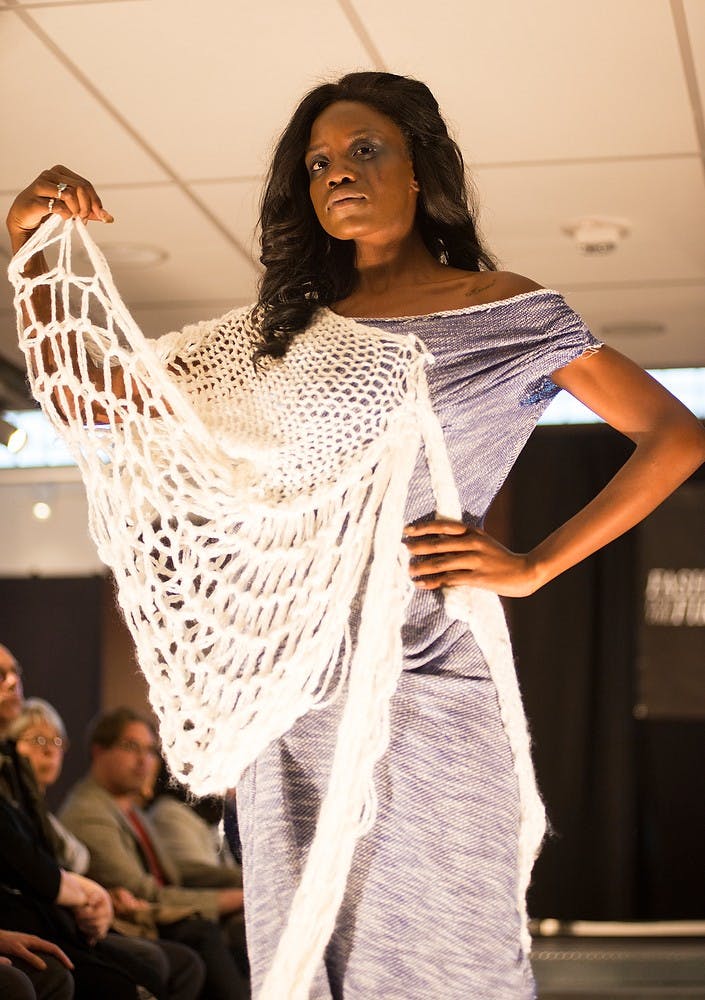Since apparel and textile design senior Katie Raynard was a little girl, fashion has always been a part of her life.
Raynard, who started her life watching her mother sew her figure skating costumes, has now found herself behind her own sewing machine. The difference is she’s now doing it to foster her other passion: social justice.
Recently, Raynard combined the two in the form of “Fashion for the Fire,” an avant-garde fashion show that debuted at The Runway in Lansing this past Saturday.
All of the clothes featured in the show were inspired by the stories of sexual assault survivors.
Raynard said she first came up with the idea for the show a year ago after completing a few fashion pieces centered around other social justice issues.
“That kind of concept really inspired me to kind of use fashion as a greater form of communication and deliver a greater message and a greater story behind it,” she said.
She said when she was coming up with potential ideas, she decided to challenge herself and select a single topic. She then designed multiple pieces that would tell a story centered around that one topic.
At first, Raynard wasn’t entirely sure what topic to cover. But she ended up finding one that hit close to home. One of Raynard’s closest friends opened up to her about her personal experiences with sexual assault.
“I was really inspired by her,” Raynard said. “(She) actually graduated college, and this was such a powerful woman, and also she had such heart to fight against sexual trauma.”
Raynard then reached out to apparel and textile design senior Anami Chan to help her design clothes for the show.
Chan said she is incredibly passionate about social justice issues, and that passion is what drew her to helping Raynard out.
Reaching out
Determined to make their visions come to life, Raynard and Chan reached out to Tashmica Torok, executive director of the Firecracker Foundation. This organization provides therapy to children who survived sexual trauma.
Torok said she thought their idea was a fantastic one right from the get-go.
“I really feel it’s very important to share stories in as many different ways as we can,” Torok said. “I think it’s the best way to get people involved and interested if you speak their language. Fashion, although of course I love it, is not my language.”
Torok then reached out to survivors of sexual trauma associated with the organization to see if they would share their stories and be a part of the event.
MSU alumna Kimberly Kaiser was one of the survivors who chose to participate. She said she’s been in public projects that highlight the journey of a survivor, but never a fashion show.
Regardless, Kaiser said she was immediately excited to be a part of it.
“It’s just such a new way to talk about violence because they’re making these pieces based off stories,” she said. “I think it’s just going to pull in such a different crowd. It’s going to pull in such a different demographic. So many different people will be able to see it.”
Raynard said the next step of the project was to interview the survivors about their experiences, a task which seemed incredibly daunting at first.
Raynard said she and Chan weren’t entirely sure how to go about it at first, but then decided it would be best to give the survivors a few guiding questions to get them thinking, and then just let them share what they were comfortable with.
Chan said hearing their stories was an experience like no other.
“Their journeys are incredible,” she said. “I think it’s great to hear that side of their story. They were really open about what they had been through. It’s moving in a way that’s hard to explain, but then also easy to explain at the same time.”
Creating the clothes
The next step was to design and create the clothes. Raynard said when she was coming up with ideas for her pieces, she mainly focused on emotions and the words the survivors used when describing their journeys. She then translated those into different colors and fabrics.
For example, if a survivor described feeling especially vulnerable, sheer or opaque fabrics were used to represent that.
Leather, on the other hand, was used to demonstrate toughness or strength. Mixed fabrics were used to convey conflicting or simultaneous feelings.
Chan and Raynard said the survivors had seen some sketches and pictures from the process, but the final results were a surprise until the show. Raynard said she was a little nervous about what the survivors would think of their pieces, but mostly she was excited.
“I hope they feel we have done their story justice,” she said before the show debuted. “I’m very excited to see their reactions also. We want to bring to light the journeys of survivors of sexual trauma so the public is aware of the implications of this. I hope (the survivors) are very pleased with it and also see it as a celebration of who they are.”
The show’s debut
The crowd sat silently, mesmerized, as the model gracefully strutted down the runway.
She wore a white bodysuit with sheer long sleeves and black fabric cut into feather-like shapes at the chest. Sheer white fabric flowed elegantly behind her, and sashayed as she made her way down the runway.
The front and back of the piece were both adorned with tiny lights.
An audio recording of Torok recounting her experiences of being sexually assaulted by her father when she was a little girl played in the background.
Except for the audio, the room was dead quiet. The audience eyed the model in awe, captivated by what she was wearing, but were also visibly moved by the story unfolding in the background. Most people kept a straight face, others occasionally had to dab their eyes with a tissue.
This project has been a year-long journey for Raynard and Chan, but they both said it has also been a life-changing experience.
“It’s nerve-wracking and exciting all at the same time,” Chan said. “Although I wasn’t able to see them walk down the runway, just kind of seeing them go down the stairs, it was kind of just that amazing feeling ... between being nervous and exhilarated at the same time, which I can’t even explain.”
Torok said she really enjoyed the show.
“I think it’s always interesting to hear the stories and the fashion, you know, when everything comes together, you just never know what to expect so it exceeded my expectations by far,” she said.
Torok said she was especially impressed with the pieces inspired by her. The other two pieces consisted of two leather-like black dresses, one with a centered slit at the bottom, and another with metallic gold features and matching leggings.
Raynard said “Fashion for the Fire” has inspired her to continue fighting for social justice issues.
She plans to develop the idea of fashion representing social justice issues into a company that will combine the elements of fashion, advocacy and art to further different causes.
Raynard said the show couldn’t have been more of a success.
“We couldn’t be happier with everything — we just couldn’t,” she said. “We were just so blown away by the community support and interest in this. Just working with the foundation, working with all of our sponsors and contributors, everyone contributed so much and that’s what brought the whole event together.”







